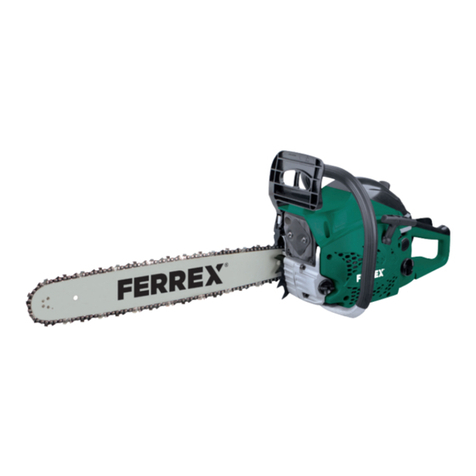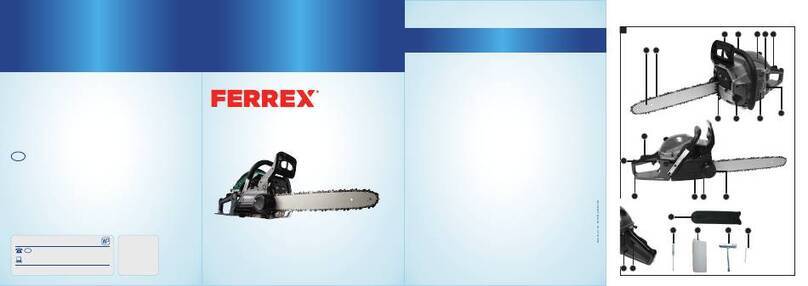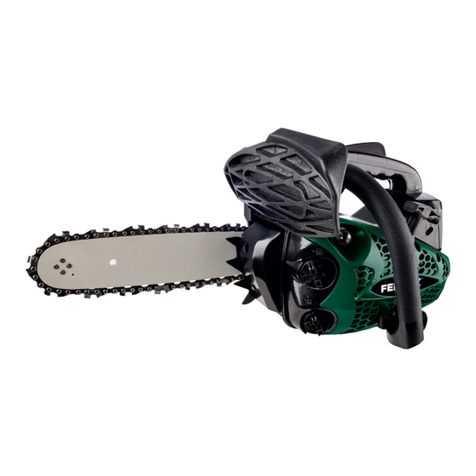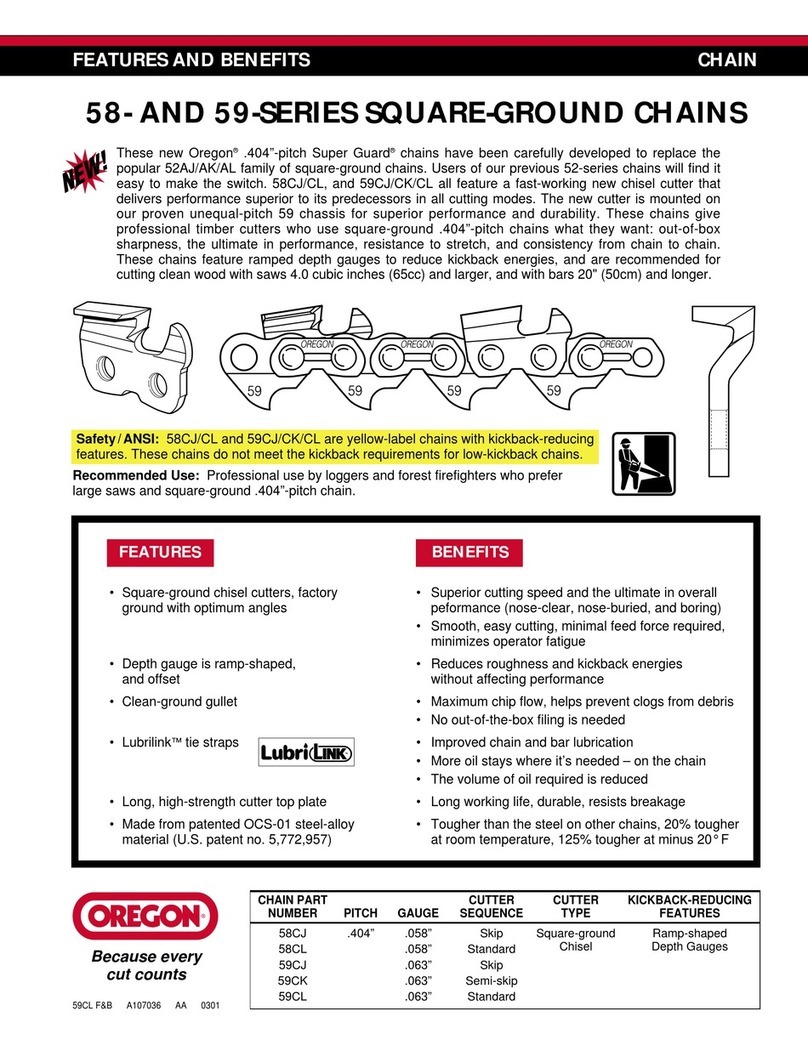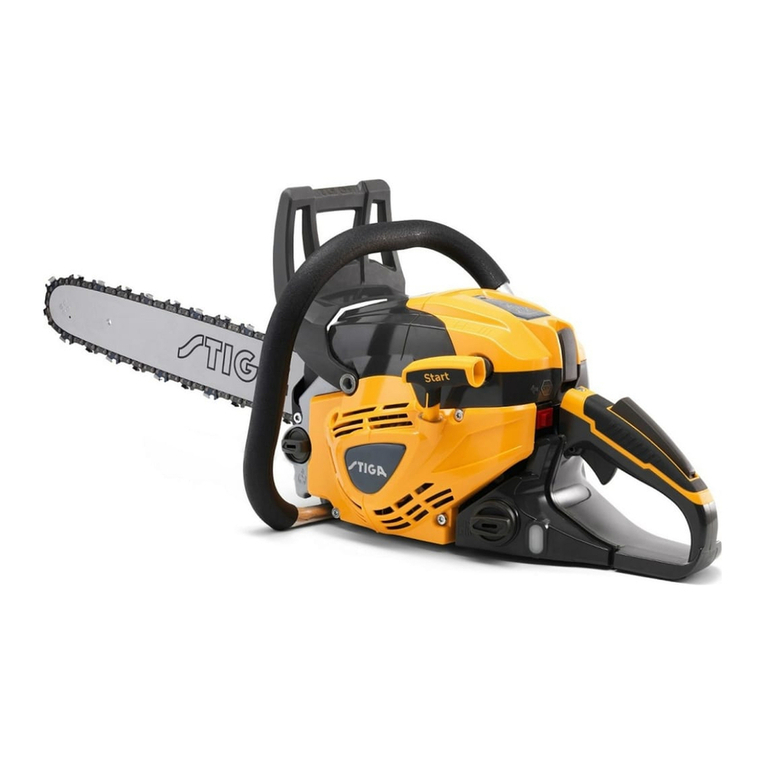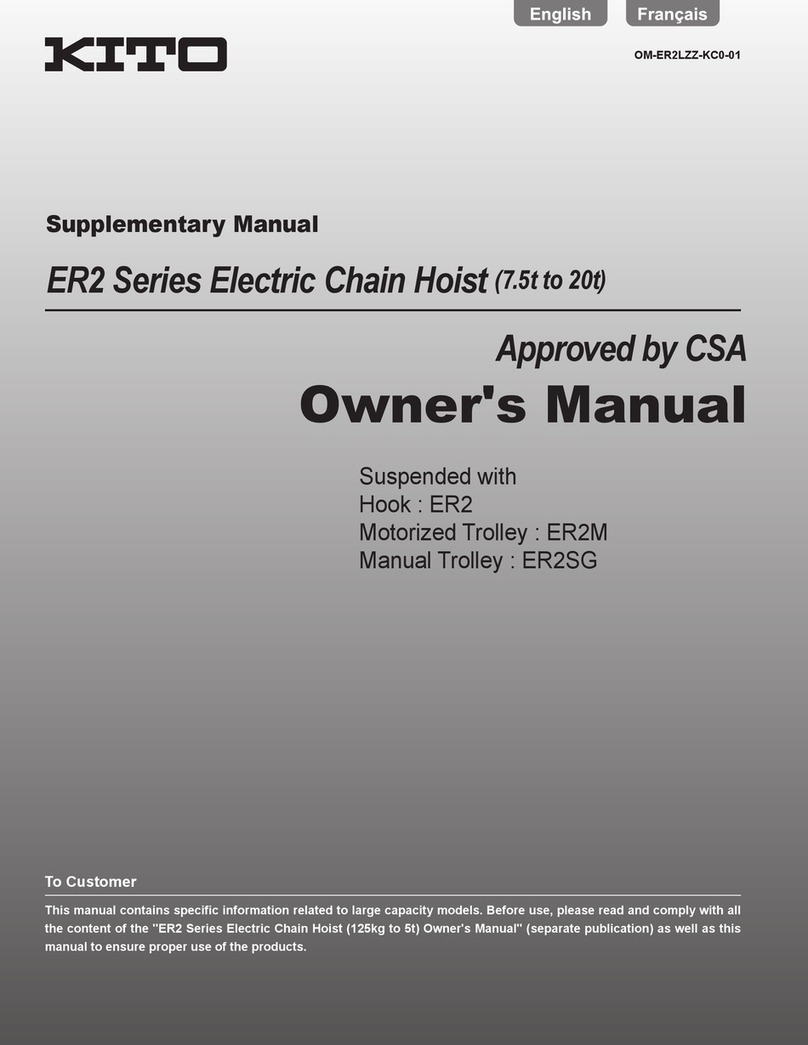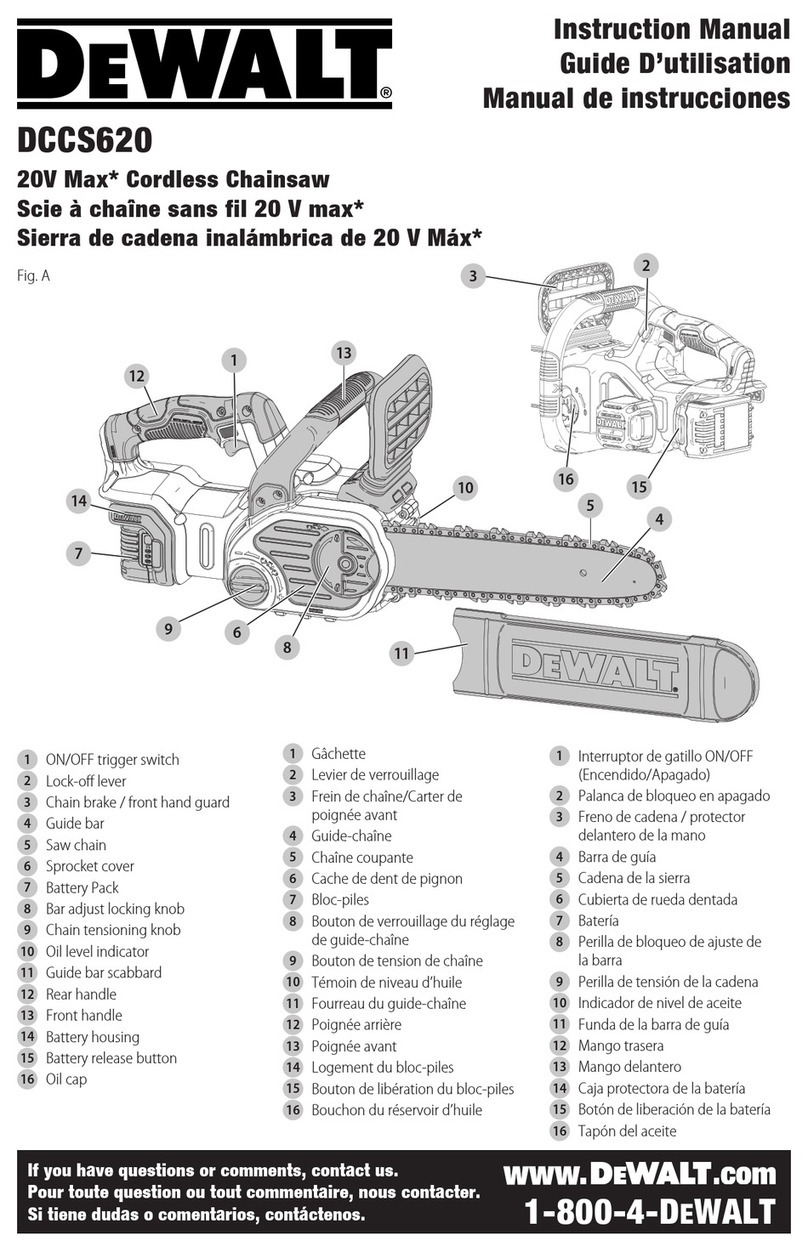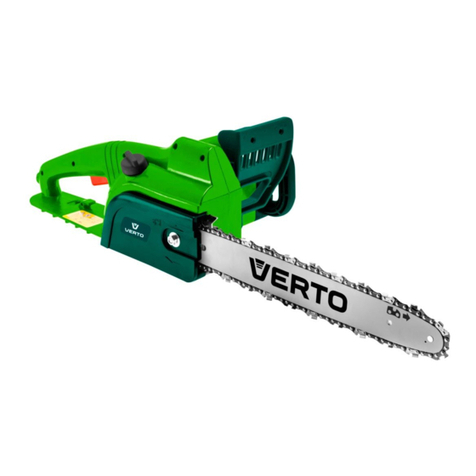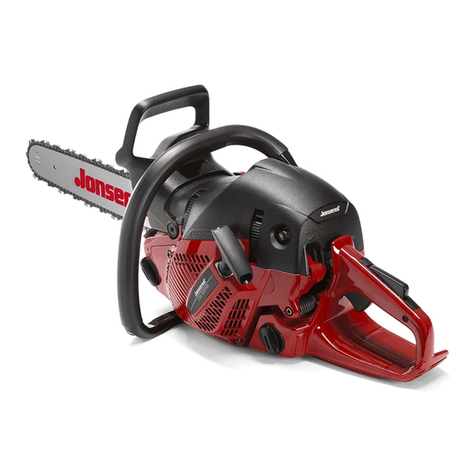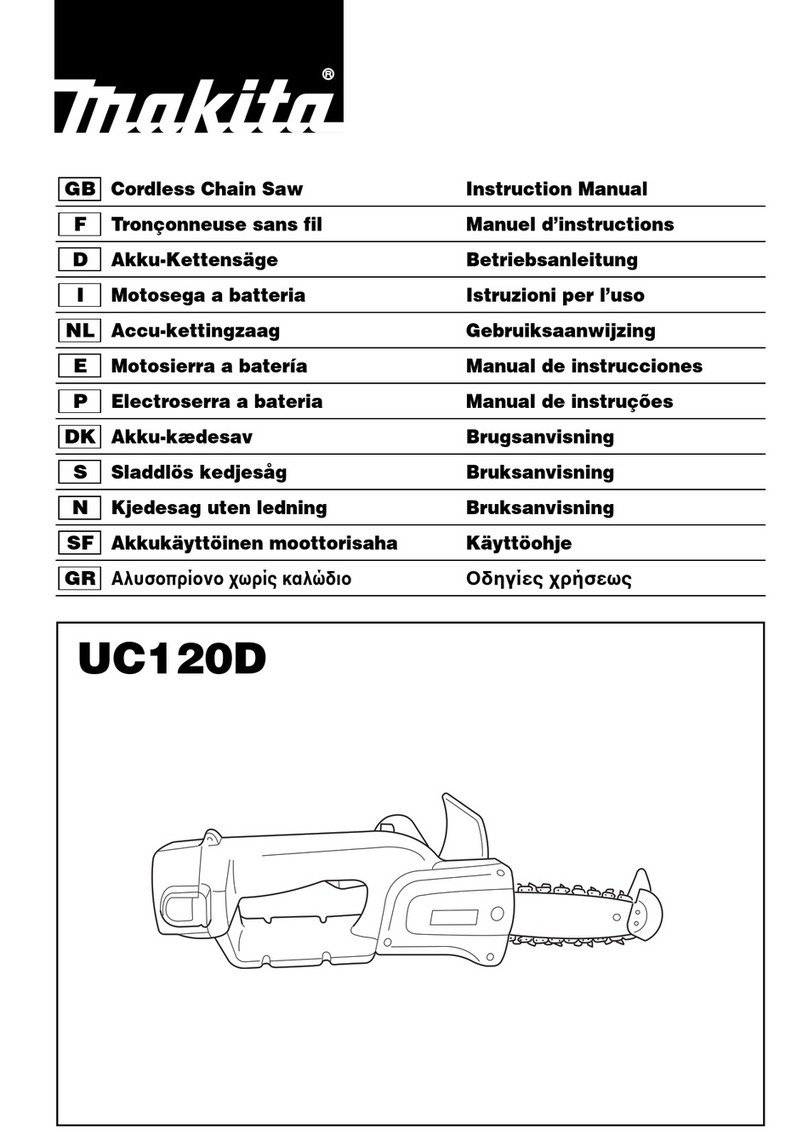FERREX CSP50 User manual

Contents
PETROL CHAINSAW CSP50
User Manual
AFTER SALES SUPPORT 708115
1300 855 831
MODEL:
CSP50
3
YEAR
WARRANTY
AU
Made in China
FERREX®is a registered trademark of ALDI Stores
DISTRIBUTED BY:
ALDI STORES
1 SARGENTS ROAD
MINCHINBURY NSW 2770
www.aldi.com.au
AU
ALDI guarantees that our exclusive brand products are developed to our
stringent quality specifications. If you are not entirely satisfied with this
product, please return it to the nearest ALDI store within 60 days from the
date of purchase, for a full refund or replacement, or take advantage of our
after sales support by calling the supplier’s Customer Service Hotline.
04/2022
Explanation of the symbols on the device 08
Introduction 11
Device description 12
Scope of delivery 13
Proper use 13
Safety information 14
Technical data 20
Before commissioning 21
Commissioning 24
Basic working instructions for felling work 28
Working on tensioned wood 30
Transport 31
Cleaning and maintenance 31
Storage 36
Troubleshooting 37
Warranty Details 39
Repair and Refurbished Goods or Parts Notice 41

Package contents/part list
1 x Chainsaw
1 x Saw chain
1 x Guide bar
5 64
4
CD
E F
I
G
16
A23 4
9
10
11
12
131415
161718
202122
1 5 6 7
8
19
23242526
27
16
28
17
29
30
31
B
1
H
abc
J
K L
1 x Spark plug wrench / slotted screwdriver
1 x Mixing container
1 x Cover for the guide bar (chain guard)
1 x Round saw chain file
1 x Operating manual
1 x Screwdriver
1 x Warranty card

NM O
32
5
33
3

8
Symbole
Warning! When working with the chainsaw particular
safety measures are required. Read and observe all
warning information!
Warning! Risk of kickback. Protect yourself from
kickback from the chainsaw and avoid all contact
with the bar tip.
Do not use the chainsaw one-handed.
Always use the chainsaw with both hands.
Wear a safety helmet with face protection or safety
goggles and hearing protection.
Read through the whole operating manual carefully
before rst use and keep this safely for future
reference.
Wear protective gloves.
1. Explanation of the symbols on the device
Explanation of the symbols on the device

Bedienung
9
Explanation of the symbols on the device
Wear non-slip safety shoes!
Wear close-tting protective clothing with a cut
protection insert.
Fuel ller cap.
Never work without chain lubrication! Always check
chain lubrication before starting work.
CHOKE
Choke knob
10x
Press the fuel pump primer 10x
Adjustments for carburettor:
( L ) Low Speed
( H ) High Speed
( T ) Idle Speed
Chain brake (open/closed)

10
Symbole
Running direction of the chain
Guaranteed sound power level of the device
Warning - Hot surfaces!
On-/O Switch - “ON“
On-/O Switch - “STOP“
Weight
Fuel mixing ratio
Avoid contact with the bar tip.
Naked ames or smoking near the device is strictly
prohibited!
Explanation of the symbols on the device

11
Introduction
2. Introduction
Congratulations on choosing to buy a FERREX® product.
All products brought to you by FERREX® are manufactured to the highest standards of per-
formance and safety, and as part of our philosophy of customer service and satisfaction, are
backed by our comprehensive 3 Year Warranty.
We hope you will enjoy using your purchase for many years to come.
Note:
According to the applicable product liability law the manufacturer of this device is not liable
for damages which arise on or in connection with this device in case of:
• improper handling,
• non-compliance with the instructions for use,
• repairs by third party, non-authorised skilled workers,
• installation and replacement of non-original spare parts,
• improper use.
Recommendations:
Read the entire text of the operating instructions prior to the assembly and operation of the
device.
These operating instructions are intended to make it easier for you to get familiar with your
device and utilise its intended possibilities of use.
The operating instructions contain important notes on how to work safely, proper-
ly and economically with your machine and how to avoid dangers, save repair costs,
reduce downtime, and increase the reliability and working life of the machine.
In addition to the safety regulations contained herein, you must in any case comply
with the applicable regulations of your country with respect to the operation of the
machine.
Keep the operating instructions in a clear plastic folder to protect them from dirt and humi-
dity; store them near the machine.The instructions should be read and carefully understood
by each operator prior to using the machine. Only persons who have been trained in the use
of the machine and are aware of the related dangers and risks should be allowed to use the
machine. The local required minimum age must be met.
In addition to the safety notes contained in these operating instructions and any specic
regulations in your country, the generally recognised technical rules for the operation of
identically constructed machines must be observed.

12
3. Device description (Fig. A , N, O)
1. Front hand guard
2. Front handle
3. Air lter cover
4. Start pull cord
5. Lock for the air lter cover
6. On/o switch
7. Fuel pump primer
8. Cold start lever (choke)
9. Throttle interlock
10. Throttle
11. Rear handle
12. Rear hand guard
13. Fuel tank cap
14. Chain oil tank cap
15. Claw stop (pre-assembled)
16. Guide bar
17. Saw chain
18. Bench grinder aid
19. Oil adjustment screw
20. Fixing nuts
21. Chain tensioning screw
22. Chain cover
23. Chain tensioning pin
24. Chain catcher
25. Hole for the chain tensioning pin
26. Chain wheel
27. Guide bar cover
28. Spark plug wrench / slotted screwdriver
29. Round saw chain le
30. Screwdriver
31. Mixing container
32. Air lter
33. Spark plug connector
Device description

13
Scope of delivery/Proper use
4. Scope of delivery
• 1 Chainsaw
• 1 Guide bar
• 1 Saw chain
• 1 Spark plug wrench / slotted screwdriver
• 1 Cover for the guide bar (chain guard)
• 1 Mixing container
• 1 Round saw chain le
• 1 Screwdriver
• 1 Operating manual
• 1 Warranty card
5. Proper use
The chainsaw may only be used for cutting wood outdoors. The chainsaw must not be used
for any other purpose.
Do not make any modications to the chainsaw. Safety may be compromised as a result.
The user/operator, not the manufacturer, is responsible for damages or injuries of any type
resulting from this. Please note that this device was not designed for commercial use.
We assume no guarantee if the equipment is used in commercial or industrial applications,
or for equivalent work.
First-time users must be instructed to familiarise themselves with the features of the device.
Attend a state chainsaw training course for your safety.
Please observe that our equipment was not designed with the intention of use for commer-
cial or industrial purposes. We assume no guarantee if the equipment is used in commercial
or industrial applications, or for equivalent work.
5.1 Non-approved operators:
People who are not familiar with this operating manual, children under the age of 16 and
people under the inuence of alcohol, drugs or medication are not permitted to operate the
device.
National regulations may restrict the use of the device!

14
6. Safety information
IMPORTANT!
READ CAREFULLY BEFORE USE AND STORE SAFELY FOR FUTURE REFERENCE.
mDANGER
For an imminent danger that will lead to severe personal injury or death.
m WARNING
For a potentially dangerous situation that can lead to severe personal injury or death.
mCAUTION
Information on a potentially dangerous situation that can lead to minor injuries.
m ATTENTION
Information on a potentially dangerous situation that can lead to property damage.
6.1 General safety instructions
m WARNING
Always remain attentive, pay attention to what you are doing and be sensible when working
with the device. Do not use the device while ill or tired or under the inuence of drugs, al-
cohol or medication. A moment of carelessness when using the device can result in serious
injuries.
Avoid misuse, use the machine only as described under“Intended use”.
■Before start-up, read the operating manual for your device and pay particular attention to
the safety instructions.
■Warning and information labels attached to the device provide important information for
safe operation.
■In addition to the information in the operating manual, the general safety and accident
prevention regulations of the legislature must be observed.
■Keep packaging material away from children, there is a risk of suocation!
■Inadequately informed operators can endanger themselves and others through improper
use. The operator is responsible for the safety of third parties.
■Be very attentive when handling the device. Go about your work sensibly and pay close
attention to what you are doing.
■Do not work for more than 10 minutes at a time. It is advisable to take a break of 10 - 20
minutes between operations.
Safety information

15
Safety information
■Only lend the device to users who have experience with the device.The operating manual
must be handed over at the same time.
■Some cutting tasks require special training and skills. If you have any doubts, consult a
specialist.
■First-time users must be instructed to familiarise themselves with the features of the de-
vice. Attend a state chainsaw training course for your safety.
■When not in use, the device must be set down in such a way that no one is endangered.
Secure from unauthorised access.
■The user of the device is responsible for all accidents and hazards that cause damage to
other people or their property.
■Children, young people and persons with reduced physical, sensory or mental abilities
must not use the chainsaw. Exceptions exist only for young people over 16 years of age in
the context of training under the supervision of a professional.
■The electric ignition system of the device generates a low electromagnetic eld. If you
wear a pacemaker or similar implant, consult your doctor before using the device to avoid
health risks.
■Please note that improper maintenance, the use of non-compliant spare parts, or the re-
moval or modication of safety devices can result in damage to the device and serious
injury to the person working with it.
6.2 Personal Protective Equipment (PPE)
mDANGER
Always wear personal protective equipment (PPE)!
-Wear a safety helmet with face protection or safety goggles and hearing protection.
-Wear close-tting protective clothing with a cut protection insert.
-Wear non-slip safety shoes.
-Wear protective gloves.
■Avoid loose clothing that can get caught.
■Do not wear a scarf, tie or jewellery!
■If you have long hair, use a hair net!
■Wear a safety helmet for all work in the forest.This provides protection from falling branch-
es. Check the safety helmet regularly for damage. This must be replaced after 5 years at
the latest. Only use approved safety helmets.
■The face guard or safety goggles protect against shavings and wood splinters. To prevent
injuries to the eyes, you must always wear a face guard or safety goggles when working
with the device.
■Always wear hearing protection.The noise emitted by the device may cause hearing dam-
age.
■Wear robust protective gloves made of tough material, such as leather.
■Wear a dust protection mask when sawing dry wood. Sawdust may form.

16
6.3 Storage and transport
■Switch o the chainsaw before any transport, even over short distances. Engage the chain
brake and t the chain guard.
■Use the chain guard during transport and storage.
■Secure the machine against tipping over during transport (including in vehicles) to pre-
vent fuel loss, damage or injury.
■Carry the device only by the front handle. In doing so, the guide bar points backwards,
away from your body (see g. L).
■Keep the hot silencer away from your body.There is a risk of burns!
■Clean and maintain the chainsaw before storage.
■Store the device in a safe and dry location. Also secure it from unauthorised access.
6.4 Environmental safety
■National and/or municipal regulations may impose time restrictions on the use of
noise-generating, motorized devices. Ask your local administration about this.
■The device must not be operated indoors or in other poorly ventilated areas. There is a
danger of suocation due to the toxic exhaust gases / lubricating oil vapours.
■Only carry out work in daylight.
■Also, do not work in adverse weather conditions, such as rain or wind.There is an increased
risk of accidents here.
■Keep your work area clean and tidy.
■Keep children, other people and animals away before and during work. If distracted, you
can lose control of the device.
■Before starting work, make sure that there are no persons, animals or property in the dan-
ger zone.
■Do not work near wire fences or in areas with loose old wire.
■Have re extinguishers ready when working in highly ammable environments such as
dry grass, etc. There is a risk of re!
6.5 Filling with fuel
■Petrol is very easily ammable. Keep away from naked ames when refuelling and do not
smoke while doing so.There is a risk of re!
■Be careful not to spill petrol. Ensure that no petrol or chain oil gets into the soil. Use suita-
ble sheeting or similar to help with this.
■Refuel only in well-ventilated areas. Petrol vapours can easily ignite or explode.
■Switch o the engine before refuelling and allow the device to cool down. If petrol has
been spilled, clean the aected areas immediately. Also, do not let any fuel get on your
clothes, otherwise change immediately.
■Also avoid skin and eye contact with petrol or lubricants (oil).
■Do not breathe in fuel vapours/lubricating oil vapours.
■Watch out for leaks. If petrol is leaking, do not start the engine. There is a danger from
burns.
Safety information

17
Safety information
■Carefully open the tank cap so that any overpressure can slowly escape and no petrol
sprays out.
6.6 Before start-up
m WARNING
Always carry out checks before use and with the engine switched o.
Check the device before each use and after it has fallen to the ground to ensure that it is in
safe operating condition.
Check that all moving parts are working properly. Many accidents are caused by poorly
maintained tools. Have damaged parts repaired by qualied specialist personnel.
Only use the chainsaw and accessories in accordance with these instructions. taking into
account the working conditions and the work to be performed. Using power tools for oper-
ations other than those intended can lead to hazardous situations.
■Regularly check the chain brake for proper functioning (front hand guard, see g. D).
■Check the guide bar to make sure it is mounted correctly.
■Check that the saw chain is properly tensioned. Follow the instructions for lubrication,
chain tensioning and replacing accessories. An improperly tensioned or lubricated chain
can break or increase the risk of kick-back.
■Keep cutting tools sharp and clean. Sharpen regularly and replace worn parts in good
time. Properly maintained cutting tools with sharp cutting edges are less likely to bind
and are easier to control.
■Check that the throttle and the throttle interlock move easily. The throttle lever must
spring back to the starting position.
■Check that there is enough fuel and chain lubricating oil in the tank.
■Check that the handles are clean, dry and free from oil and dirt.
■Never carry out the work alone. In an emergency, someone must be nearby.
■Only use the chainsaw when standing on rm, safe and level ground. Do not overreach.
Slippery ground or unstable standing surfaces (e.g. on a ladder) can cause loss of balance
or loss of control of the chainsaw. Keep proper footing and balance at all times. This will
allow you to better control the chainsaw in unexpected situations.
■Do not work with the chainsaw in a tree. There is a risk of injury when operating in a tree.
■Never saw above shoulder height.
■Always hold the chainsaw with your right hand on the rear handle and your left hand on
the front handle (see g. D). Holding the chainsaw using the opposite grip increases the
risk of injuries and must be avoided.
■Keep all body parts away from the saw chain when the chainsaw is running. Before start-
ing the chainsaw, ensure that the saw chain is not touching anything.When working with
a chainsaw, a moment of carelessness can result in clothing or body parts being caught
by the saw chain.

18
■Switch o the chainsaw immediately if you notice any noticeable changes in the device’s
behaviour.
■If the chainsaw has come into contact with stones, nails or other hard objects, stop the
engine immediately and check the saw chain and guide bar for damage.
■Do not drop the chainsaw, do not hit it against obstacles and never use the guide bar as
a lever.
■Only saw in wood with the chainsaw.
■When cutting a branch that is under tension, expect it to spring back. If the tension in
the wood bres is released, the tensioned branch can hit the operator and/or wrest the
chainsaw from control.
■Be especially careful when cutting undergrowth and young trees. The thin material can
get caught in the saw chain and hit you or throw you o balance.
6.7 Vibrations
m WARNING
Avoid the risks associated with vibration, e.g. the risk of white nger syndrome (circulatory
disorders) by taking frequent breaks from work where you rub your palms together, for ex-
ample.
■Always wear protective gloves and make sure your hands are warm.
■Make sure that the chain is always sharp.
■Take regular breaks from work.
6.8 Precautionary measures against kick-back
m WARNING
Watch out for kick-back when working with the device. There is a danger of injury. Avoid
kick-backs through caution and correct sawing technique.
■Touching with the tip of the guide bar can sometimes lead to an unexpected backward
reaction, whereby the guide bar whips up and in the direction of the operator.
■Kickback can arise if the tip of the guide bar touches an object or if the wood bends and
the saw chain jams in the cut.
■If the saw chain jams on the top edge of the guide bar, the chainsaw can jerk back sudden-
ly in the direction of the operator (g. I).
■If the saw chain jams on the lower edge of the guide bar, the chainsaw can jerk forward
suddenly away from the operator (g. J).
■Be extremely careful when using the chain of the chainsaw to continue cutting into a cut that
has already been started.
■Do not saw branches or pieces of wood that could change their position during the saw-
ing process or where the cut closes during the sawing process.
Safety information

19
Safety information
■Each of these reactions can lead to you losing control of the saw and possibly suering a
serious injury. Never rely solely on the safety equipment integrated in the chainsaw. As a
chainsaw user, take various measures to work without accidents and injuries.
Kick-back is the result of incorrect or decient use. It can be prevented by suitable precau-
tionary measures, as described in the following:
■Hold the saw rmly with both hands, with the thumbs and ngers enclosing the chainsaw
handles. Bring your body and arms into a position in which you can absorb the kickback
forces. If suitable measures are implemented, the operator will be able to withstand the
kick-back forces. Never let go of the chainsaw (see g. D).
■Avoid an unusual body stance and never saw above shoulder height. This will help to avoid
unintentional contact with the guide bar tip, and enable improved control of the chainsaw in
unexpected situations.
■Always use replacement guide bars and saw chains prescribed by the manufacturer. In-
correct replacement guide bars and saw chains may cause the saw chain to break and/or
lead to kick-back.
■Adhere to the instructions of the manufacturer when sharpening and maintaining the
saw chain. If the depth limiter is too low, this increases the tendency towards kick-back.
■Do not saw with the tip of the guide bar. There is a risk of kick-back.
■Make sure that there are no nails or metal pieces in the cutting area. Pay special attention
to nails or pieces of iron around the cutting area. Also be careful when sawing hardwoods
where the chain can get caught. This can cause kick-back.
■Start cutting at full power and always keep the chainsaw at maximum speed while sawing.
■Make sure that there are no objects on the oor that you can trip over..
6.9 Residual risks
mDANGER
RISK OF INJURY !
Contact with the saw chain can lead to fatal cuts.
Never touch the saw chain with your hands while it is running.
RISK OF KICK-BACK !
Kick-back can lead to fatal cuts.
DANGER OF BURNING !
The chain and guide bar heat up during operation.

20
7. Technical data
Weight unfuelled, without cutting gear approx........5.2 kg
Weight unfuelled, with cutting gear approx. ............6.4 kg
Fuel tank ......................................................ca. 550 cm3(550 mL)
Tank for chain lubricating oil................ca. 260 cm3(260 mL)
Usable cutting length* /
Guide bar.......................................................................44 cm (18“)
Max. chain speed..................................................................22m/s
Chain pitch...................................................... 8.255 mm (0.325“)
Driving link thickness....................................... 1.5 mm (0.059”)
Type of saw chain ........................KANGXING : 325-058-72BL
Type of guide bar .......................KANGXING: BE18-72-5810P
Chain wheel tooth pitch............ 7 teeth/8.255 mm (0.325“)
Engine displacement ....................................................................... 45 cm3
Max. engine power output per ISO 7293.................................. 1.8 kW
Idle speed n0........................................................................................ 3400 min-1
Speed nmax ............................................................................................ 12000 min-1
Spark plug............................................................................................ L8RTF
* The actual cutting length may be less than the specied cutting length.
Noise
Sound pressure level LpA per ISO 22868.............111.4 dB(A)
Uncertainty KpA ..........................................................................3 dB
Sound power level LWA
per ISO 22868 ..............................................................113.0 dB(A)
Uncertainty KWA .........................................................................3 dB
Wear hearing protection.
Excessive noise can result in a loss of hearing.
The specied device emissions values have been measured in accordance with a standard-
ised test procedure and can be used for the comparison of one tool with another.
The specied noise emission values can also be used for an initial estimation of the exposure.
Technical data

21
Technical data/Before commissioning
Vibration
Vibration value at the rear
Handle per ISO 22867......................................................6.4 m/s2
Vibration value at the front
Handle per ISO 22867...................................................6.96 m/s2
Uncertainty K ......................................................................1.5 m/s2
m WARNING
Avoid the risks associated with vibration, e.g. the risk of white nger syndrome (circulatory
disorders) by taking frequent breaks from work where you rub your palms together, for ex-
ample.
8. Before commissioning
• Open the packaging and carefully remove the device.
• Remove the packaging material, as well as the packaging and transport safety devices (if
present).
• Check whether the scope of delivery is complete.
• Check the device and accessory parts for transport damage.
• If possible, keep the packaging until the expiry of the warranty period.
ATTENTION
The device and the packaging are not children‘s toys! Do not let children play with plastic
bags, lms or small parts! There is a danger of choking or suocating!
8.1 Mounting the guide bar and tensioning the saw chain
m ATTENTION
Always carry out assembly with the engine switched o.
m WARNING
Risk of injury!
Always wear protective gloves when touching the saw chain (17). Danger of injury due to
the sharp cutting teeth!
Note
A new saw chain (17) stretches and needs to be retensioned more often. Check and adjust
the chain tension regularly after each cut.
Depending on wear, the guide bar (16) can be turned.

22
• Set the chainsaw down on a level and stable surface.
• Pull the front hand guard (1) back as far as it will go to release the chain brake (see g. B).
• Remove the two xing nuts (20) with the spark plug wrench (28).
• Remove the chain cover (22).
• Slide the slotted hole of the guide bar (16) over the two protruding pins.
• Place the saw chain (17) over the teeth of the chain wheel (26). Insert the saw chain (17)
accurately in the direction indicated on the guide bar (16). In the tip of the guide bar (16)
there is a guide wheel into whose teeth the saw chain (17) must be inserted.
• Pull slightly on the guide bar (16) to slightly pre-tension the saw chain (17).
• Fit the chain cover (22) back on. Make sure that the internal chain tensioning pin (23) ts
into the matching hole (25) in the guide bar (16). If necessary, adjust the chain tensioning
screw (21) with the spark plug wrench / slotted screwdriver (28).
• Screw on the two fastening nuts (20) by hand. However, make sure that you do not tighten
them yet.
• Use the spark plug wrench / slotted screwdriver (28) to turn the chain tensioning screw
(21) clockwise until the lower part of the saw chain (17) slides into the guide bar (16). The
saw chain (17) must be in contact with the underside of the bar. When the chain brake is
released, it must be possible to pull the saw chain (17) over the guide bar (16) by hand.
Note
A new saw chain (17) stretches and needs to be retensioned more often.
• Tighten the two xing nuts (20) with the spark plug wrench / slotted screwdriver (28).
8.2 Mixing fuel
The engine must be operated with a fuel mixture of petrol and engine oil.
m WARNING
Avoid direct skin contact with fuel and inhalation of fuel vapours.
Use only a mixture of unleaded petrol (min. RON 95) and special 2-stroke engine oil (JASO
FD/ISO - L - EGD). Mix the fuel mixture as per the fuel mixing table.
Put the correct amount of petrol and 2-stroke oil into the enclosed mixing bottle (31) (see
“Fuel mixing table”). Then shake the mixing container (31) well.
Before commissioning

23
Before commissioning
8.2.1 Fuel mixing table
Mixing process: 40 parts petrol to 1 part oil
Petrol ............................................................2-stroke oil
0.5 litre.................................................................12.5 ml
8.3 Filling with fuel
m WARNING
Only ll the fuel when the engine is switched o and has cooled down.There is a risk of re!
• Always clean the area around the fuel tank cap (13) before lling to prevent dirt from fall-
ing into the fuel tank. Use a dry, lint-free cloth for this purpose.
• Lay the device on its side with the fuel tank cap (13) facing upwards.
• Turn the fuel tank cap (13) anti-clockwise and open it. The fuel tank cap (13) is connected
to an anti-loss device in the fuel tank and thus cannot fall o.
• Pour the fuel mixture into the fuel tank. Do not spill fuel when refuelling and do not ll the
fuel tank to the brim.
• Wipe up spilled fuel immediately.
• Turn the fuel tank cap (13) clockwise to close it.
NOTE
Also check the chain oil after each fuel ll.
8.4 Filling with chain oil
m WARNING
Only ll the saw chain oil when the engine is switched o and has cooled down. There is a
risk of re!
Never work without chain lubrication! If the saw chain runs dry, the cutting gear will be
irreparably destroyed in a short time.
Always check chain lubrication before working.
NOTE
Use only saw chain oil. Preferably biodegradable. Do not use waste oil, engine oil, etc.
Check during work that the chain lubrication is working.
• Always clean the area around the chain oil tank cap (14) before lling so that no dirt falls
into the chain oil tank. Use a dry, lint-free cloth for this purpose.
• Lay the device on its side with the chain oil tank cap (14) is facing upwards.
• Turn the chain oil tank cap (14) anti-clockwise and open it. The chain oil tank cap (14) is
connected to an anti-loss device in the chain oil tank and thus cannot fall o.

24
Symbole
• Pour the chain oil into the chain oil tank. Do not spill chain oil when refuelling and do not
ll the chain oil tank to the brim.
• Wipe up spilled chain oil immediately.
• Turn the chain oil tank cap (14) clockwise to close it.
8.5 Tensioning and checking the saw chain
m WARNING
Put on protective gloves! Danger of injury due to the sharp cutting teeth!
Check the chain tension regularly before each start-up.
• Before tensioning, loosen the two xing nuts (20) a little with the spark plug wrench /
slotted screwdriver (28).
• Turn the chain tensioning screw (21) clockwise with the spark plug wrench / slotted
screwdriver (28) to increase the tension.
• Tighten the two xing nuts (20) with the spark plug wrench / slotted screwdriver (28).
• The saw chain (17) must be in contact with the underside of the guide bar. Check whether
the saw chain (17) can be pulled over the guide bar (16) by hand (with the chain brake
released, pull the front hand guard (1) back).
NOTE
A new saw chain (17) stretches and needs to be retensioned more often.
9. Commissioning
mCAUTION
Please observe the legal provisions from the noise protection ordinance.
Before each start-up, check the device for the following:
• Check the fuel system for leakage
• Faultless condition and completeness of the guards and the cutting device
• Tight t of all screw connections
• Smooth running of all moving parts
Working instructions
Familiarise yourself with handling the chainsaw before use.
Before commissioning/Commissioning
Table of contents
Other FERREX Chainsaw manuals
Popular Chainsaw manuals by other brands

Echo
Echo CS-8000 TYPE1-E instruction manual

Garland
Garland MONTANA 920 instruction manual

Husqvarna
Husqvarna T540 XP II Operator's manual
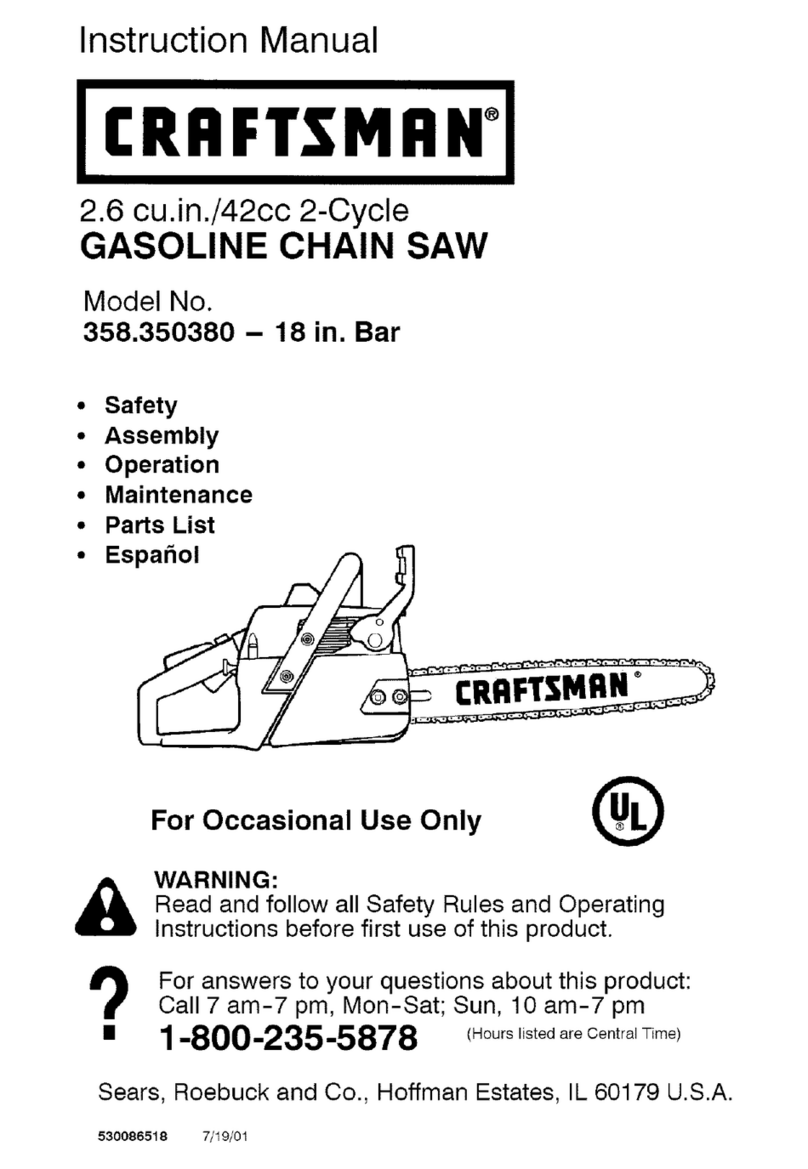
Craftsman
Craftsman 358.350380 instruction manual
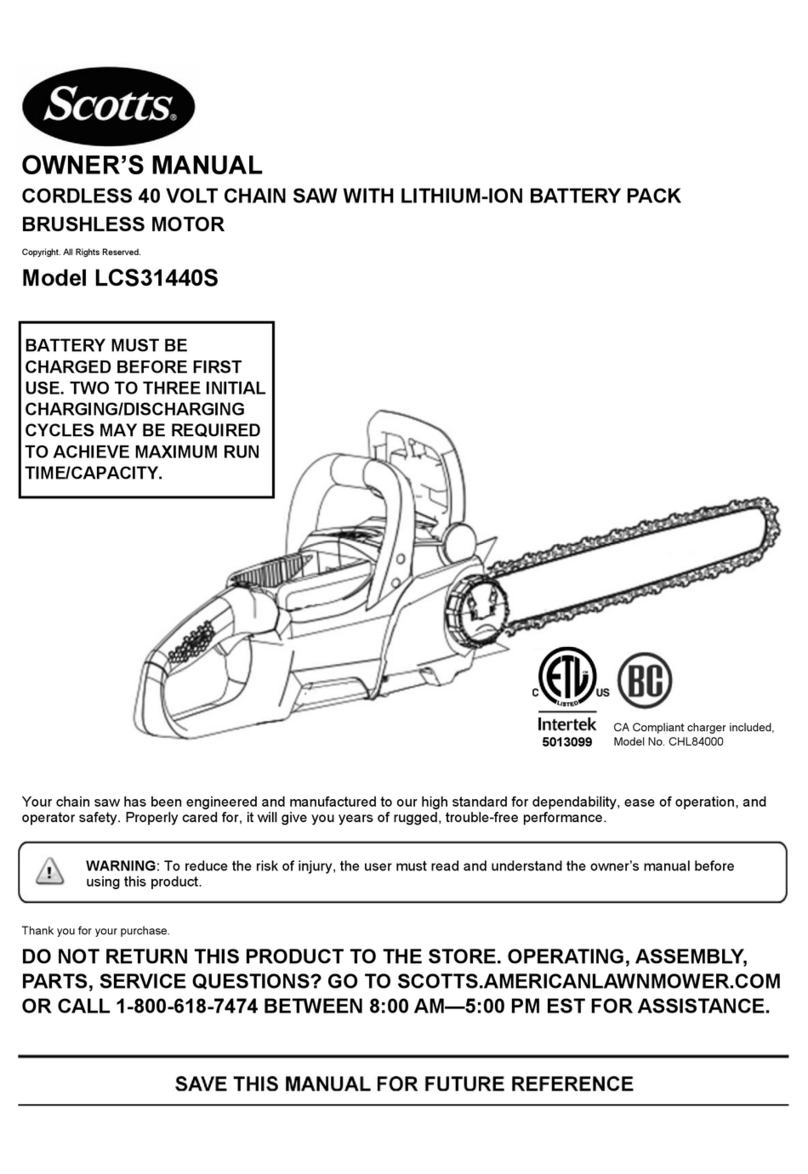
Scotts
Scotts LCS31440S owner's manual
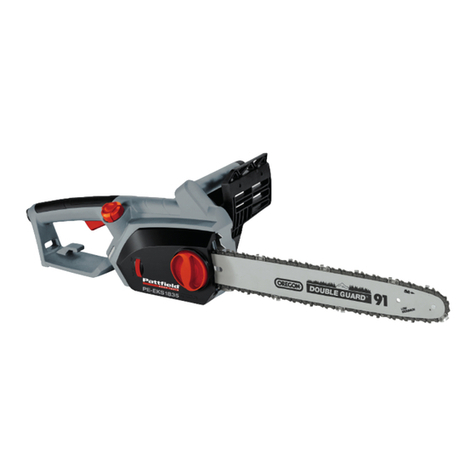
Pattfield Ergo Tools
Pattfield Ergo Tools PE-EKS 1835 Original operating instructions
